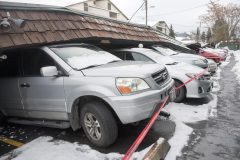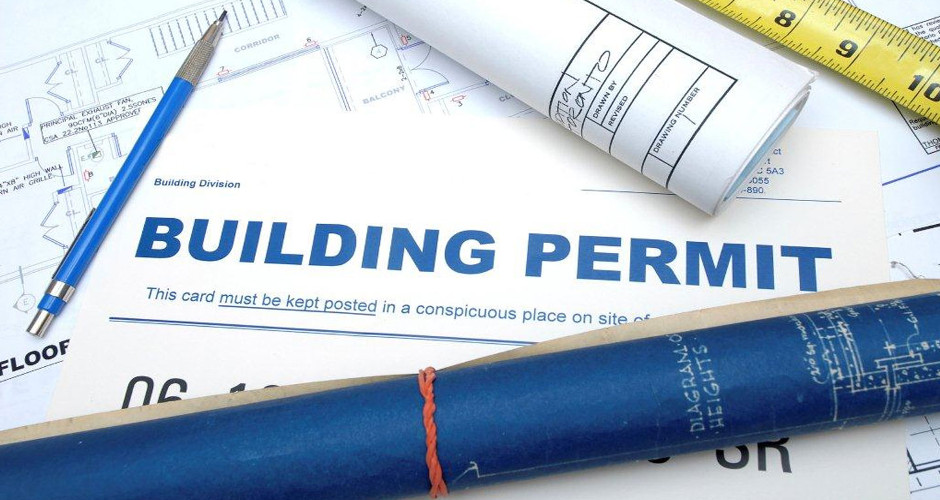A building fell down.
Someone said, “There oughta be a law.”
Someone made a law.
A building fell down, again.
Building codes are like gun control: Neither achieves their stated goal; both create bureaucracy; both diffuse responsibility. All a builder needs show is that he “built to code,” how then can a court of law find him responsible for a structural failure? He built to code. A prominent local architect wrote, “I can see you are wanting to find responsibility in one profession, or institution, and that isn’t how this industry works.”
In my opinion, the “institution” of government washed its hands of responsibility by adopting codes with “minimum standards” that “professions” are bound to follow. The consumer pays the consequences. Decisions in multiple court cases lead one to conclude that building codes are a “get out of jail free” card and not the rallying cry for safety and consumer protection as touted.
The ancient code of Hammurabi offered more protection: If a builder builds a house for someone, and does not construct it properly, and the house which he built falls in and kills its owner, then that builder shall be put to death. Ancient Babylon offered no get out of jail free cards to the building trades.
Good builders build good structures using best practices regardless of code. Bad builders know how to work the system building bad structures regardless of code. Where government didn’t adopt code, lenders offer construction loans if the builder has demonstrated good construction, ditto insurance companies. Bad reputation, no loan to build, no projects, bad builders out of business; that is how the free market operates and why the free market is successful…until government gets involved.
BUILDING CODE CREATORS
County commissioners are considering options regarding the International Building Code (IBC) as adopted by the Idaho Building Code Board (IBCB) in 2017 session. Idaho statute allows local governments the choice to adopt the entire code or no part of the code: all or nothing. Kootenai County ordinances relating to building construction only apply to the unincorporated areas of Kootenai County (KC), in other words outside of city limits. Fewer than 30 percent of KC residents live in the rural areas affected by decisions regarding 2017 IBC adoption, the “code.”
What is the IBC and the International Code Council, Inc. (ICC)? The ICC is a private nonprofit entity that creates the IBC building “code” based upon the so-called “minimum standards.” Government entities are encouraged to support the ICC and purchase the ICC work product and adopt laws embracing those IBC “building codes,” stating “safety” as the reason. That adopting government then merely provides oversight and acts as the enforcement arm on behalf of the “code.” Neither the “code” creators nor the government entities who adopt/enforce the “code” have accountability in the event of failure of a structure built to the IBC “code.”
The origin of ICC? The ICC is a private non-profit company created in 1994 whose stated intent was to consolidate and eliminate the three other codes then in use in the USA. Their membership consists of some 64,000 private/public sector individuals who direct creation of the IBC. Even though the Council and Code chose the name “International” rather than “National,” the primary sphere of adoption remains the USA, US territories and some developing nations. According to the website of the International Code Council, Inc. their bylaws proclaim they are a 501(c) (6) California Nonprofit Public Benefit Corporation. Many folks moving to Idaho expected to escape California’s excessive rules by moving to Idaho…not. It would be interesting to know by “following the money” trail just how many millions (or billions) of dollars of annual non-profit revenue this ICC-IBC private entity brings in and the tax liability born by taxpayers for the “service.”
ABOUT SNOW LOADS
On January 5, 1997 a Spokesman-Review article regarding collapses of many north Idaho buildings in past winters and revising snow load requirements: Rick Ulveling, Idaho State Building Inspector providing oversight in the five northern counties, recognizes that the existing 40 pound standard for snow load is insufficient and recommends boosting that capacity to 50, 60 and 70 pounds as needed. Engineer Jim Meckel believes current standards are too low but “describes the problem as one of risk management” and “a philosophical question.”
Others believe the 40-pound load is adequate. Kootenai County (KC) Chief Building Official Dave Daniels says parts of KC accumulate in excess of 40-pound snow loads. Daniels then consults with North Idaho Building Contractors Association (NIBCA) and Daniels then maintains there is no evidence to support increasing snow load standards. Meckel and Ulveling maintain that it might “be too risky not to increase snow loads.” Increased snow load recommendations ignored due to; cost, risk is acceptable, occurrence is infrequent. Bonner and Boundary counties also suffered failures that winter due to excessive snow loads the most notable being public school buildings.
On March 11, 1997, Spokesman-Review article regarding Bonner and Boundary County school snow loads and failures: Sen. Shawn Keough introduced SB1180 to require “school roofs to meet standards set in a University of Idaho study that examined snowfall and other factors around the state.” Keough states, “I cannot in good conscience send my 7-year-old or any of the children of Idaho to schools that are in this condition,” Keough said. “This is the right thing to do, and I urge your support.” Keough said roofs on school buildings in Boundary County were built to withstand only 30 pounds per square foot – leaving them vulnerable.
The article reports, “For Bonner County, the study calls for roofs that can withstand snow loads of up to 100 pounds per square foot. Bonner schools were built to a standard of 40 pounds per square foot.” Further, we find “In addition to setting the higher standard for new school buildings, the bill would have required all existing school buildings to be inspected. Districts would have had to have developed plans to fix those found short of the standard. Sen. Robert Lee, R-Rexburg, said he wouldn’t mind the standards for new buildings but applying them to existing schools “carries a big, big price tag.” The outcome? Sen. Shawn Keough waged a fight in the Senate, but her bill to require stricter snow-load standards for school roofs failed by five votes, 15 to 20. Another philosophical question, or?
 On December 2009, a report by the Spokane Chapter of Structural Engineers Association of Washington (SEAW) reported 108 structural failures in Spokane and Kootenai County due to heavy snow, winter of 2008-2009. Of the 108, 95 sustained structural failure, while 13 exhibited excessive roof deflection and cause for concern or evacuation. The structures failed as insufficiently constructed to support the actual snow load. Over half the buildings were constructed after the advent of building codes. Those built before the advent of code had survived 40 plus years. The oldest building survived 90 winters, four buildings survived 1 winter. The nine Idaho structures in the report were of a commercial type, seven were built to code, age and code adherence of ice rink is unknown, the oldest structure was 40 years old and predated code by 5 years, and the newest was only 1 year old.
On December 2009, a report by the Spokane Chapter of Structural Engineers Association of Washington (SEAW) reported 108 structural failures in Spokane and Kootenai County due to heavy snow, winter of 2008-2009. Of the 108, 95 sustained structural failure, while 13 exhibited excessive roof deflection and cause for concern or evacuation. The structures failed as insufficiently constructed to support the actual snow load. Over half the buildings were constructed after the advent of building codes. Those built before the advent of code had survived 40 plus years. The oldest building survived 90 winters, four buildings survived 1 winter. The nine Idaho structures in the report were of a commercial type, seven were built to code, age and code adherence of ice rink is unknown, the oldest structure was 40 years old and predated code by 5 years, and the newest was only 1 year old.
On February 6, 2017, a Spokesman article again: Heavy snow loads with failed structures in Spokane. State structural engineers recommended Spokane county increase their insufficient current 30-pound snow load minimum to 39-pound snow load minimum. The Spokesman-Review photo of a flattened carport and smashed cars at a Spokane apartment complex made a good argument to increase the snow load requirement. Engineer’s recommendation rejected though cause, effect and solution were provided. Politics & special interests again rear their heads.
FAILURES IN SPITE OF CODE COMPLIANCE
Each year new and old buildings alike fail in spite of every aspect of rigid subjection to code compliance. It appears the quantity of failures diminish as the weak fail, the strong survive, trial and error reveal what works and what will not. Engineers constantly evaluate failures to define the failsafe structure. As seen above, words of warning often falls upon deaf ears, or, upon ears that ignore. What recourse do the owners of the failed structures have? Who is responsible in the event of failure? Not the code maker as code is merely a guideline without warranty; not the county or city department who reviewed the plans and inspected the project during construction to ensure code compliance as code is a guideline and state statute holds government not liable. If fault can be attributed to architect, engineer or the builders and the owner has the financial means, desire, and a good lawyer, then court is an option of recourse. Unfortunately and all too often, the responsible party is whom you see in the mirror each morning, ourselves. I beg then two answers; one, if the code and government deny responsibility, what value is gained from either; two, is it better to hire a professional who does take responsibility?
In Kootenai County, we are fortunate to have many good people in the building industry that take great pride in their work, strive for customer satisfaction, and guarantee their work! Beware, there are a few who do not share that work ethic. An informed homeowner who seeks good builders, architects and engineers and verifies their references will avoid disappointment; a hopeful new homeowner who lacks sufficient knowledge of the building trade is wise to seek the services of a reputable consultant; the result is a fine new home that stands the test of time. The person who neglects due diligence or neglects to seek good counsel will face disappointment or worse.
2015-17 Boise, Idaho, Boise Foothills Terra Nativa, third phase, upscale subdivision: Permitted by City of Boise, typical engineering, surveys, roads, water, power, architectural, permitting, plan review and inspection followed adopted construction standards and certificate of occupancy issued. Ground starts moving, new homes sliding and crumbling, roads, water, power & other infrastructure failures. Homes condemned by Boise, Boise orders homeowners to dismantle homes. Lawsuits ensue. Recourse – Evidently, it was known by prior city councils that the area was the subject of an early 1970s landslide and condemned the site; a later council removed the condemnation and allowed building. Gross negligence maybe, sue and win court case, possible but questionable. Recourse with service providers, nada, if processes followed per approved standards. Insurance, how many even dreamed of geo seismic insurance? Homeowners apparently did their due diligence after the fact, face foreclosure, banking loss and cost of lawsuits.
While code supporters seem to be in lockstep with retort to code failures along the lines of, save the code, code is not at fault, instead make tighter adherence. Safety, safety, safety….really? The government’s best efforts could not prevent the prior mentioned events from happening. Was everybody involved with Terra Nativa an incompetent moron? I think not, there were fine engineers, architects and builders and government building officials involved in both projects. Buildings and bridges fail in earthquakes, lessons are learned and the next building or bridge is better, trial and error. Rather it seems the “save the code” at all costs argument reeks of concerted “education” by special interest groups preserving at all costs their profitable and bureaucracy building ICC/IBC cash cow. At the public’s expense!
Consumer protection? What is a reasonable and cost-effective home warranty for what will likely be our largest lifetime investment, 1 year? We expect what? If Big Brother mandated a 20 year home warranty few could afford a home. Good builders already use “best practices” and stand by their work for many years. Due diligence in selecting architect and builder is the sure path to satisfaction. Big Brother only creates a false sense of security.
Compliance? How many water heaters were sold last year by Ziggy’s, Home Depot, Lowes, Sears and myriad other suppliers? How many permits were issued to install water heaters last year? The same number of permits as units sold? How many folks realized permits were needed? No escape from bureaucracy even to the point of replacing a water heater. Some will hire a professional and those capable may take the DIY route. Home Depot and Lowes each provide instructions to replace gas or electric versions. Who adamantly supports the bureaucratic permitting requirement? Is it simply job security for Big Brother? How much damage resulted last year from bad installations?
Idaho has x realtors, x bankers, x appraisers, x builders, x developers, x remodelers, x insurers, x code officials and each of their related associations/lobbyists. Can they gain any advantage from instituting regulation? If the answer is no, then why do some groups persist in lobbying for regulation? Peer pressure from “code” makers? Does big biz gain the advantage over small biz? For profit, though code, is touted and alleged to enhance safety?
The agriculture industry is one of, if not the most powerful lobby groups in the state; they managed to exempt Ag buildings from code requirements. Good for them, they banded together and banished the red tape. An Ag related pole barn can be constructed without bldg. codes; the identical building. to accommodate your non-Ag related machinery, tools, cars, boats, stuff, etc., is subject to code. Even though these same items and uses could be Ag related IF one had a farm; the intent of the Constitution is equal treatment, does the Idaho law allowing Ag building exemption but not the identical non-Ag building meet the equality test?
In an Insurance Journal article from 8/31/2017 are several comments regarding Texans resolve to combat bureaucracy, Building Code Politics; “Texas policies leave home building decision to cities”… “Any proposal that would increase costs in Texas draws pushback from home builders, a powerful group in a state where people despise red tape about as much as they hate taxes”… “They are not big on regulation,” said Julie Rochman, chief executive officer of the insurance institute”… “Building codes elicit little support in Austin”… “Ned Muñoz, vice president of regulatory affairs for the Texas Association of Builders, said cities already do a good job choosing which parts of the building code are right for them…Muñoz said his association’s target is “unnecessary and burdensome government regulations, which increase the price of a home”… The fight in Texas is a microcosm of a national battle.
The International Code Council, a Washington nonprofit made up of government officials and industry representatives, updates its model codes every three years, inviting state and local governments to adopt them. Last year, the National Association of Home Builders boasted of its prowess at stopping the 2018 codes it didn’t like. “Only 6 percent of the proposals that NAHB opposed made it through the committee hearings intact,” the association wrote on its blog.” Though the likely intent of the author is casting shame, my response is God Bless Texas they want less red tape.
The architectural, engineering and construction industry has learned much since those days. The best laid plans and efforts were subjects of trial and error. Today is the peak of architecture, engineering, and construction knowledge. The frequency of catastrophic failure is diminished though failure still occurs as seen in prior examples. Every tomorrow is the next peak of knowledge and the failures of the prior day will not be repeated the following day. Credit for that success is due to the shared trial and error knowledge of engineers, architects and builders. The “best practices” standard embodies this cumulative knowledge and results in sound structures according to the best knowledge of the day.
However there is a hitch; the double standard known as the “minimum standards” as used in the ICC code. These are generated and driven by politics/special interests/profits and how much red tape the public will tolerate. Structures that are minimally sound are the result of this standard. Safety and uniformity are buzzwords, for example, engineer’s recommendations regarding adequate snow loads that may not be heeded due to cost.
Most Americans have an aversion to special interest groups and monopolies that create circumstances beneficial to their own interests. It is surprising that a private non-profit California corporation (ICC) with members from private and public sectors which exists solely to create the “code” and which bind standards nationwide hasn’t been scrutinized (or challenged or questioned). Why not and what are those reasons? The western states clamor for local control and chide the bureaucracy and liberalism of California. And yet Idaho embraces ICC codes?



